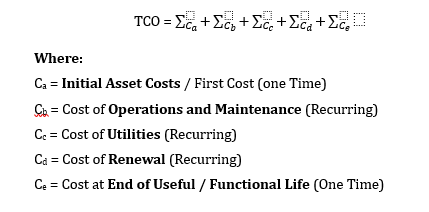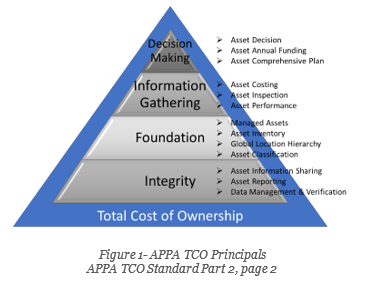By: Ana Thiemer—Associate Director at The University of Texas at Austin, & Dana K. Smith, FAIA Emeritus, FbSI
What happens when we merge our facility’s data, internal expertise, and knowledge with industry standards and best practices? The effect is informed decision-making at the highest level. Every entity strives to reduce risk and make the most informed asset and facility decisions. With a Total Cost of Ownership (TCO) strategy, decisions become more dependable, and risk is mitigated on a higher level.
To begin, the TCO definition found in Part 1 of the APPA standard is as follows:
A holistic approach to maximizing return on investment of managed physical assets includes the summation of all known and estimated costs to have first, recurring, renewal/replacement, and end-of-useful life costs revised at critical decision points to aid in life-cycle asset management decisions.
Simply, TCO is a summation of costs and can be represented by the formula:

Thirteen principles accompany the definition and guide an organization to full TCO implementation (See figure 1). Implementation of all of the TCO principles is the vision but starting with one or a few basic TCO principles is the place to begin. A summary of key elements identified in each of the principles includes:
Integrity
- Asset Information Sharing shall be implemented to ensure data collection is minimized and to ensure everyone is working from the same data for decision making.
- Comprehensive and continuous Asset Reporting shall be implemented to convey key information about all assets throughout the organization to support planning and decision-making.
- Accurate information founded on good Data Management and Verification strategies shall be implemented organizationally.

Foundation
- Managed Assets shall be applicable to land parcels, facilities, structures, infrastructure, and equipment.
- A detailed Asset Inventory shall be maintained.
- All fixed assets shall be located using a Global Location Hierarchy using a globally unique identifier.
- All assets shall be organized using an Asset Classification
Information Gathering
- Asset Costing shall use the standard TCO framework.
- A continuous process of Asset Inspection shall be initiated as part of everyday business.
- Asset Performance is a key metric that shall be assessed as a baseline and during normal operation to ensure optimum efficiency.
The previous ten principles all lead to being able to make better decisions using the following three principles:
Decision Making
- Asset Decisions shall be made based on a Strategic Asset Management Plan.
- Asset Annual Funding shall be projected for near and long term and updated annually.
- An Asset Comprehensive Plan shall be developed for each asset.
Begin with the End in Mind
The thirteen principles build a foundation to make effective decisions. But, what decision(s)? An organization must answer this question first to implement a strong TCO strategy.
TCO aids with decisions about:
- Procurement of new assets, products, facilities, infrastructure, and related asset selection decisions
- Sustaining and ensuring resilience of existing facilities and infrastructure assets, including renovation or removal decisions
- Long- and short-term financial planning, budget analysis, and reporting for the mission and use of managed assets
Let’s go back to the definition of TCO. The summation formula drives the basis of TCO implementation as being the lowest first cost may not be the right outcome. Decisions about facilities, assets, systems, and components span further than just a summation of cost or the lowest cost. Other factors must also be considered to make a well-educated, effective, and efficient decision. Building, space or use criticality, risk mitigation, length of asset life (not only how long an asset should last, but how long an organization plans to keep the asset to include selling, demolishing, deconstructing, abandoning, etc.), maintenance schedules, sustainability impacts, return on investment, staff, and level of training required, and future plans all play an essential role in TCO decision making. Just as new facilities are planned, designed, constructed, and added, renewals follow a similar path, affecting all aspects of the information management process. Coupled with the summation of costs from the TCO formula, the second part of the TCO definition supplies the holistic view necessary for a successful TCO implementation or the best decision-making. Hence the trigger for TCO typically is either new construction or renewal, as those are significant data gathering events.
Summary
Achieving a true Total Cost of Ownership (TCO) strategy is a collaboration of data and many other tools, including but not limited to Condition Assessments, Cost Estimating, Life Cycle Costing (LCC), Life Cycle Analysis (LCA), Value Engineering (VE), Service Life, and Lean Construction. With a Total Cost of Ownership (TCO) strategy, facilities professionals can provide solutions and reduce risk to the organizations fixed assets with existing resources found in the organization today.
About the authors:
Dana K. Smith, FAIA Emeritus, FbSI, is a facility and IT architect with experience across the entire spectrum of assets, from homeowner’s associations to one of the world’s most extensive facility portfolios. He is an author of articles and books on CAD, Specifications, Cost Engineering, BIM, Education, and many other facility-related topics. He was co-chair for the development of the APPA TCO standards Part 1 & 2.
Ana Thiemer, is an Associate Director at The University of Texas at Austin with experience across higher education facility management to include maintenance, energy management, capital renewal, asset condition reporting, project management, design, planning, cost estimating, document management, process improvement, and of course, Total Cost of Ownership. She is the author of many capital renewal, facility and TCO articles. She is a faculty member of the APPA Institute and the APPA Leadership Academy as well as facilitates leadership learning at The University of Texas at Austin.
